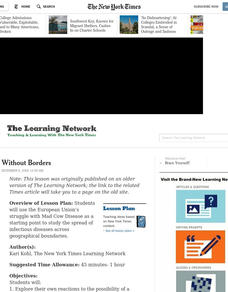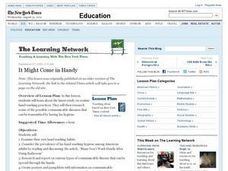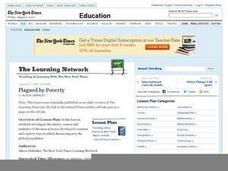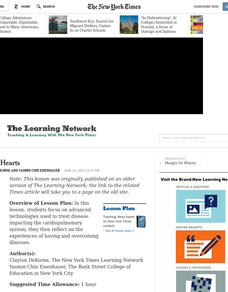Curated OER
Are Antismoking Ads Effective?
Are the anti-smoking ads put out by the federal government effective? This question is posed to your critical thinkers. They'll read excerpts from a New York Times article and then compose thoughtful blog responses to four related...
Curated OER
Deadly Diseases
Young scholars consider the social, political, environmental, economic, medical and other considerations for why particular countries experience outbreaks of certain infectious diseases.
Curated OER
Diseases Without Borders
Students use the European Union's struggle with Mad Cow Disease as a starting point to study the spread of infectious diseases across geographical boundaries.
The New York Times
Investigating the Heroin and Prescription Opioid Epidemic
How bad is the opioid crisis in America? Has it gotten worse in the last few decades? Why? High schoolers delve into these questions with a thorough and thoughtful lesson from The New York Times on heroin prescription opioids....
Curated OER
Ill At Ease
Students research infectious diseases, focusing on what scientists and journalists currently do and do not know about each one. They act as scientists or journalists as they find out more about a particular infectious disease.
Curated OER
Popularity, Publicity, and Public Service
Students discuss the issue of celebritites who speak out for certain diseases. After reading an article, they consider a doctor's perspective on the use of celebrities. In groups, they research a common disease and design a public...
Curated OER
Invisible Enemy
Students investigate parasites and the diseases they can cause and carry. They read and discuss an article, conduct research, and create a fictional studenT story about the parasite they researched.
Curated OER
It Might Come in Handy
Young scholars explore the latest study on routine hand washing practices. They research some of the possible communicable diseases that can be transmitted by having lax hygiene.
Curated OER
So Little Time
Students examine the evolution of the AIDS epidemic in various world regions during the last 22 years. They research advancements, programs, and attitudes about AIDS in various world regions They compile a "global timeline" of the AIDS...
Curated OER
Pestilence and Plague
Students investigate various disease epidemics that have devastated the world population at different points in history and examine the diseases' effects on the countries they impacted.
Curated OER
Branching Out
Students investigate the causes and effects of the spread of tree diseases in the U.S., and research certain American species of trees and the diseases that commonly threaten them. They create pamphlets to help identify healthy and...
Curated OER
Doctors as Detectives
Students consider the investigative and detective work that goes into disease control. They research specific diseases and simulate a doctor-patient diagnosis situation.
Curated OER
Changing Times, Changing Strategies
Young scholars explore the C.D.C.'s efforts to become better equipped to battle bioterrorism; they then discuss surveillance, epidemiological, and communications issues related to their program.
Curated OER
Gazing Into the Faces of AIDS
Students consider whether or not there are generalizations that can be made about people who are infected with H.I.V. or who have the AIDS virus. They create public service ad campaigns to educate the public and consider other ways to...
Curated OER
Straining to Understand Viruses
Students examine the differences among the strains of deadly viruses and create research-based visual displays about the origins of different strains, transmission, symptoms, treatments and historic impact of specific viruses.
Curated OER
Student Investigation on the Immune System and Hemeagglutination
Students perform an experiment to demonstrate the principles of antibody-antigen binding, the secondary immune response, cross reactivity, and complement fixation. The materials to be used include antibodies from a rabbit that was...
Curated OER
Immune System: The Master of Self-Defense
Students examine the role of the immune system in the human body. They conduct a hand-washing experiment, answer questions while viewing videos, discuss key vocabulary, draw and label illustrations, and observe demonstrations and record...
Nikola Tesla documentary student worksheet
PBS documentary: Tesla - Master of Lightning; this worksheet will keep the students engaged while watching this excellent documentary about Tesla. The documentary can be found on Netflix or YouTube. It will take two class periods to...
Curated OER
Policies of Containment
Pupils examine SARS outbreak in Toronto and its impact on the economy, government and society. They, in groups, research policies and programs designed to curb the spread of diseases, and create presentations assessing their effectiveness.
Curated OER
Plagued by Poverty
Students investigate the nature, causes and statistics of diseases in lesser-developed countries and explore ways in which disease impacts the global population. They write a speech regarding disease in their country and how to prevent it.
Curated OER
Invisible Invaders
Students research various epidemics that have devastated the world population focusing on the historical events taking place during the times of the epidemics and the epidemics' effects on these societies.
The New York Times
Sequencing the Stages: Understanding H.I.V. Infection at the Molecular Level
How does HIV operate at the molecular level? Pupils discover the progression from a healthy immune cell to one infected with HIV, watch an animation of the HIV life cycle, and finally identify each of the stages with illustrations...
Curated OER
Devil May Care?
Students study about a deadly disease decimating the Tasmanian devil population. They research diseases that affect animals and write a fictional story about the animals they researched.
Curated OER
Healthy Hearts
Students focus on advanced technologies used to treat disease impacting the cardiopulmonary system; they then reflect on the experiences of having and overcoming illnesses.

























